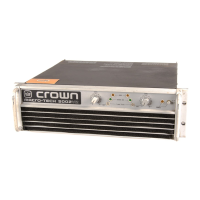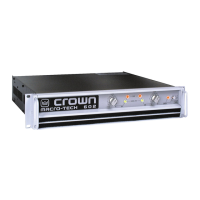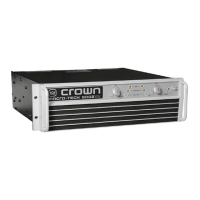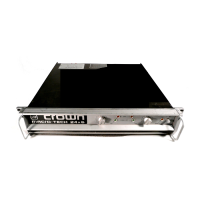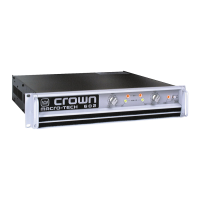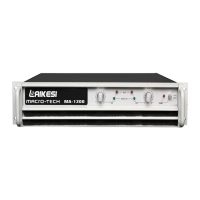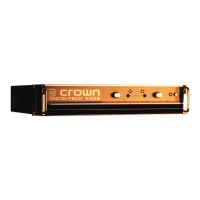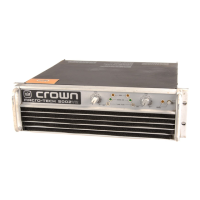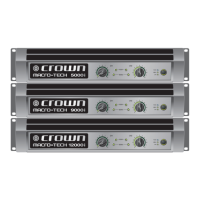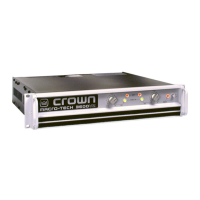Inverting
Stages
Overall
the
amplifier
is
non-inverting.
Four stages within
the
amplifier,
however,
do
invert
the
audio signal
for a net
norHnversion.
The
individual stages are:
the
BGS, which
inverts
the
audio;
the
Variable
Gain
Stage,
which inverts
it
back,
the
input
side
of
U106
and
U107
which
drivetheVoltageTranslatorsre-invertsthe
audio
(the
VoltageTranslators
are
a
common-base
confíguration
for
high voltage gain);
and
finally
the
LVA's
invert
the
audio
for the
last
time
for a net
non-inversion
through
the
amplifier.
PROTECTION SYSTEMS
The
MA-5000VZ
has
several protection mechanisms
to
limit drive
or
shutdown
the
amplifier completely
in the
event
of a
fault
of
almost
any
kind. Mechanisms include:
ODER
(covered in
depth
previously),
current
limit
(alsocovered
previously),
over-voltage
(on AC
mains),
DC/
LFI.commonmodeoutputcurrent.output
thermal,
transformerthermal,
FET
thermal,
loss
of AC
mains,
compression (covered
previously),
LOl
(covered previously),
and
slew
rate
limit
(covered previously).
After
any
non-latching
fault
clears
which
has
shut
down
the
amplifier,
the
ampüf
ier
will
automatically
powerback
upvía
soft-start.
Becausethe
fans within
the
MA-5000VZ
cool
the
amplifier
to,
under normal conditions, prevent
thermal shutdowns
and
ODER
limiting,
the fan
control circuit
is
also
covered
in
this section.
On the
following
pagés
you
will
f
ind
block
diagrams
of
both
the
Soft-start
circuitry
and the
overall protection scheme. Each augments
the
other.
Soft-Start
Soft-start
circuitry
controls
the
rate
at
which power
is
initially applied
to
the
primary
of the
toroid transformers
for the
high-voltage
power
supplies.
For
ease
of
explanation,
assume
the
amplifier
¡s
operating
properly
and is
just being
turned
on
from
the
front panel power switch.
Before
the
power switch
push-button
is
depressed,
the
input
to the
low
voltage
supply
is
open.
The
high voltage supply
is
isolated
via
input relay
K700
and
triac
Q701
(which
is in
parallel
with
K700).
Several
things occur immediately
at
turn-on. First
the low
voltage
supply powers
up and
produces
its
main
unregulated ±24VDC
and
regulated
±15VDC.
It
also
immediately
produces
pulsed
DC via
full-
wave
rectifier
D709/D714.
As
this occursall
op-amps
in the
amplifier
receive
power,
including
front-
end
stages,
relay
power
control
U111C,
and
standby control
U111B.
The
output
of
U111C
powers relay K700
via
relay drive transistor
Q700.
When
the
output
of
this
op-amp
goes high, Q700 turns
on and the
relay
closes.
The
output
of
U111C
is
held
low
until
the
amplifier
delay
times
out
by
comparing
a
high voltage
on its
inverting
input
to an RC
network
voltage
on its
non-inverting input. R329
and
R330
fix a
window
at
about
+10.4VDC.
Atturn-onC220(a10uFcap)isful!yd¡scharged.
Inthatfirst
instant
it
keeps
-15V
on the
non-inverting input
of
U111
C,
keeping
its
output low.
As the
capacitor charges
it
produces
a
ramped rise
in
voltage
as it
charges through R327.
After
about
4
seconds
the
voltage
between R327
and
R328 exceeds
the
window voltage
and
U111C
output
goes
high,
in
tum
causing relay K700
to
cióse.
Notes
MA-5000VZ
- 21
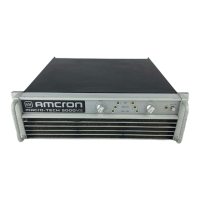
